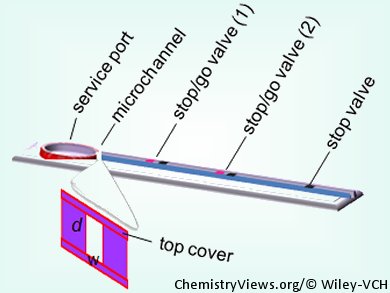It is almost like Goethe’s famous ballad, but this time the sorcerer’s apprentices know exactly what they are doing. Ioanis Katakis and colleagues, University Rovira i Virgili and iMicroQ (Integrated Microsystems for the quality of life S.L.), both Tarragona, Spain, have shown that neither broom nor bucket is needed to control flows of water; nor even a tap. Flows of aqueous solutions in capillaries can be controlled by electrochemically activated valves. Nanoporous graphitic carbon electrodes display a unique electrowetting behavior that depends on specific ion effects. These superhydrophobic electrodes benefit sequential stop-go fluidic operations such as those performed in diagnostic microsystems, which thus become more reliable and easier to handle in the field.
The team has shown how to build a device by, essentially, connecting a battery to a capillary. This allows for the controlling of its water flow by simply flipping the switch and thus applying a potential to the capillary. The concept of flow manipulation with passive valves, as the use of such electrochemically actuated stop-go valves is called, is not new. However, the incorporation of this method into a portable device had not previously been accomplished. This offers the possibility of liquid samples being in direct contact with the electrodes without undergoing electrolysis.
The next step is now to incorporate immunosensors downstream from the valves, in order to eventually build up a complete integrated analytical device. It might still be a long way to go to reach that goal, but a cornerstone has been laid.
- Eletrochemically Actuated Stop–Go Valves for Capillary Force-Operated Diagnostic Microsystems,
Alemayehu P. Washe, P. Lozano, D. Bejarano, Ioanis Katakis,
ChemPhysChem 2013.
DOI: 10.1002/cphc.201300042




